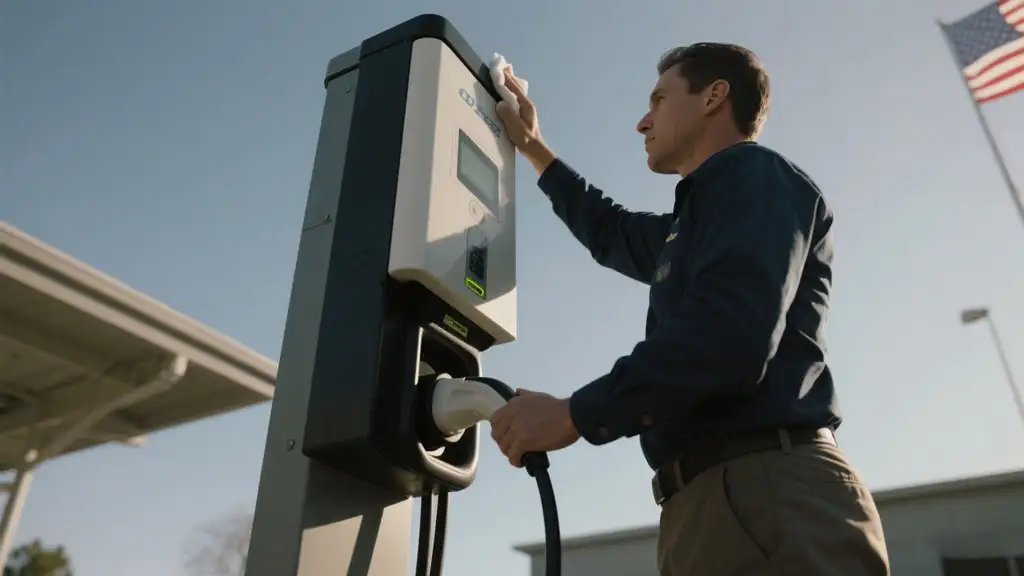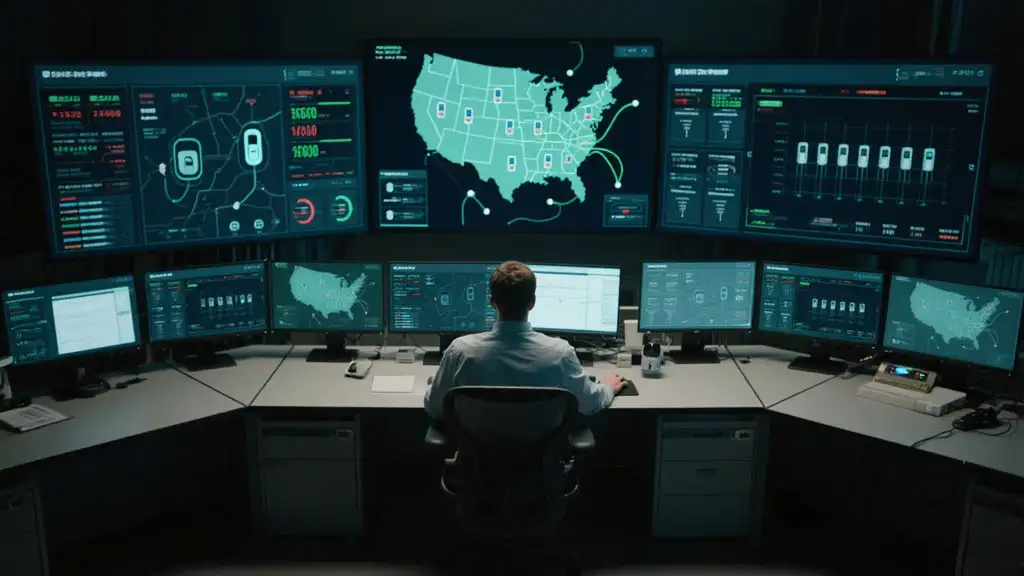"Why isn't my charging station working?" This is a question no Charge Point Operator wants to hear, but it's a common one. As an Electric Vehicle (EV) charging station operator, ensuring the stable operation of your charging points is the cornerstone of your business success. Effective EV charger troubleshooting capabilities not only minimize downtime but also significantly enhance user satisfaction and your profitability. This guide is designed to provide you with a comprehensive charging station operation and maintenance guide, helping you quickly identify and resolve common electric vehicle charging pile faults. We will delve into various challenges, from power issues to communication failures, and offer practical solutions to ensure your EVSE equipment always operates at its best.
We understand that every malfunction can mean lost revenue and user churn. Therefore, mastering effective troubleshooting strategies and implementing proactive preventive maintenance plans are crucial for any Charge Point Operator looking to remain competitive in the rapidly expanding EV charging market. This article will elaborate on how to effectively tackle various technical challenges encountered in daily operations through a systematic approach.
Understanding Common Charger Faults: Problem Diagnosis from an Operator's Perspective
Based on authoritative industry data and our experience as an EVSE supplier, the following are the most common types of electric vehicle charging pile faults, along with detailed solutions for operators. These faults not only impact user experience but also directly affect your operational costs and efficiency.
1. Charger No Power or Offline
•Fault Description: The charging pile is completely non-functional, indicator lights are off, or it appears offline on the management platform.
•Common Causes:
Power supply interruption (circuit breaker tripped, line fault).
Emergency stop button pressed.
Internal power module failure.
Network connection interruption preventing communication with the management platform.
•Solutions:
1.Check Circuit Breaker: First, check if the circuit breaker in the charging pile's distribution box has tripped. If so, try to reset it. If it trips repeatedly, there may be a short circuit or overload, requiring inspection by a professional electrician.
2.Check Emergency Stop Button: Ensure the emergency stop button on the charging pile has not been pressed.
3.Check Power Cables: Confirm that power cables are securely connected and show no obvious damage.
4.Check Network Connection: For smart charging piles, check if the Ethernet cable, Wi-Fi, or cellular network module is working correctly. Restarting network devices or the charging pile itself may help restore the connection.
5.Contact Supplier: If the above steps are ineffective, it may involve an internal hardware fault. Please contact us immediately for support.
2. Charging Session Fails to Start
•Fault Description: After the user plugs in the charging gun, the charging pile does not respond, or displays messages like "Waiting for vehicle connection," "Authentication failed," and cannot start charging.
•Common Causes:
Vehicle not correctly connected or not ready for charging.
User authentication failure (RFID card, APP, QR code).
Communication protocol issues between the charging pile and the vehicle.
Internal fault or software freeze in the charging pile.
•Solutions:
1.Guide User: Ensure the user's vehicle is correctly plugged into the charging port and is ready for charging (e.g., vehicle unlocked, or charging procedure initiated).
2.Check Authentication Method: Confirm that the authentication method used by the user (RFID card, APP) is valid and has sufficient balance. Try testing with another authentication method.
3.Restart Charger: Remotely restart the charging pile via the management platform, or power cycle it on-site by disconnecting power for a few minutes.
4.Check Charging Gun: Ensure the charging gun has no physical damage and the plug is clean.
5.Check Communication Protocol: If a specific vehicle model cannot charge, there might be a compatibility or abnormality in the communication protocol (e.g., CP signal) between the charging pile and the vehicle, requiring technical support.
3. Abnormally Slow Charging Speed or Insufficient Power
•Fault Description: The charging pile is working, but the charging power is much lower than expected, leading to excessively long charging times.
•Common Causes:
Vehicle BMS (Battery Management System) limitations.
Unstable grid voltage or insufficient power supply capacity.
Internal power module failure in the charging pile.
Excessively long or thin cables causing voltage drop.
High ambient temperature leading to charger overheating protection and power reduction.
•Solutions:
1.Check Vehicle Status: Confirm if the vehicle's battery level, temperature, etc., are limiting the charging power.
2.Monitor Grid Voltage: Use a multimeter or check via the charging pile management platform to see if the input voltage is stable and meets requirements.
3.Check Charger Logs: Review the charging pile logs for records of power reduction or overheating protection.
4.Check Cables: Ensure charging cables are not aged or damaged, and the wire gauge meets requirements. For EV charging station design, proper cable selection is crucial.
5.Environmental Cooling: Ensure good ventilation around the charging pile and no obstructions.
6.Contact Supplier: If it's an internal power module failure, professional repair is needed.

4. Charging Session Unexpectedly Interrupted
•Fault Description: A charging session suddenly terminates without completion or manual stopping.
•Common Causes:
Grid fluctuations or momentary power outages.
Vehicle BMS actively stopping charging.
Internal overload, overvoltage, undervoltage, or overheating protection triggered in the charging pile.
Communication interruption leading to loss of connection between the charging pile and the management platform.
Payment or authentication system issues.
•Solutions:
1.Check Grid Stability: Observe if other electrical devices in the area are also experiencing abnormalities.
2.Check Charger Logs: Identify the specific cause code for the interruption, such as overload, overvoltage, overheating, etc.
3.Check Communication: Confirm that the network connection between the charging pile and the management platform is stable.
4.User Communication: Ask the user if their vehicle displayed any unusual alerts.
5.Consider EV Charger Surge Protector: Installing a surge protector can effectively prevent grid fluctuations from damaging the charging pile.
5. Payment and Authentication System Faults
•Fault Description: Users cannot make payments or authenticate via APP, RFID card, or QR code, preventing them from starting a charge.
•Common Causes:
Network connectivity issues preventing communication with the payment gateway.
RFID reader malfunction.
APP or backend system issues.
Insufficient user account balance or invalid card.
•Solutions:
1.Check Network Connection: Ensure the charging pile's network connection to the payment system backend is normal.
2.Restart Charger: Attempt to restart the charging pile to refresh the system.
3.Check RFID Reader: Ensure the reader surface is clean and free of debris, with no physical damage.
4.Contact Payment Service Provider: If it's a payment gateway or backend system issue, contact the respective payment service provider.
5.Guide User: Remind users to check their account balance or card status.
6. Communication Protocol (OCPP) Errors
•Fault Description: The charging pile cannot communicate normally with the Central Management System (CMS), leading to disabled remote control, data upload, status updates, and other functions.
•Common Causes:
Network connection failure (physical disconnection, IP address conflict, firewall settings).
Incorrect OCPP configuration (URL, port, security certificate).
CMS server issues.
Internal OCPP client software fault in the charging pile.
•Solutions:
1.Check Network Physical Connection: Ensure network cables are securely connected, and routers/switches are working correctly.
2.Verify OCPP Configuration: Check if the charging pile's OCPP server URL, port, ID, and other configurations match the CMS.
3.Check Firewall Settings: Ensure network firewalls are not blocking OCPP communication ports.
4.Restart Charger and Network Devices: Attempt to restart to restore communication.
5.Contact CMS Provider: Confirm if the CMS server is operating normally.
6.Update Firmware: Ensure the charging pile firmware is the latest version; sometimes older versions may have OCPP compatibility issues.
7. Charging Gun or Cable Physical Damage/Stuck
•Fault Description: The charging gun head is damaged, the cable sheath is cracked, or the charging gun is difficult to insert/remove, or even stuck in the vehicle or charging pile.
•Common Causes:
Wear and tear or aging from long-term use.
Vehicle run-over or external impact.
Improper user operation (forceful insertion/removal).
Charging gun locking mechanism failure.
•Solutions:
1.Check for Physical Damage: Carefully inspect the charging gun head, pins, and cable sheath for cracks, burns, or bends.
2.Lubricate Locking Mechanism: For sticking issues, check the charging gun's locking mechanism; it may need cleaning or light lubrication.
3.Safe Removal: If the charging gun is stuck, do not force it out. First, disconnect power to the charging pile, then attempt to unlock it. Contact a professional if necessary.
4.Replacement: If the cable or charging gun is severely damaged, it must be immediately taken out of service and replaced to prevent electric shock or fire. As an EVSE supplier, we provide original spare parts.

9. Firmware/Software Faults or Update Issues
•Fault Description: The charging pile displays abnormal error codes, functions abnormally, or cannot complete firmware updates.
•Common Causes:
Outdated firmware version with known bugs.
Network interruption or power outage during the update process.
Corrupted or incompatible firmware file.
Internal memory or processor failure.
•Solutions:
1.Check Error Codes: Record error codes and consult the product manual or contact the supplier for explanations.
2.Retry Update: Ensure a stable network connection and uninterrupted power, then try the firmware update again.
3.Factory Reset: In some cases, performing a factory reset and reconfiguring may resolve software conflicts.
4.Contact Supplier: If firmware updates repeatedly fail or severe software issues occur, remote diagnosis or on-site flashing may be required.
10. Ground Fault or Leakage Protection Tripping
•Fault Description: The charging pile's Residual Current Device (RCD) or Ground Fault Circuit Interrupter (GFCI) trips, causing charging to stop or fail to start.
•Common Causes:
Internal leakage in the charging pile.
Damaged cable insulation leading to leakage.
Electrical leakage within the vehicle's electrical system.
Damp environment or water ingress into the charging pile.
Poor grounding system.
•Solutions:
1.Disconnect Power: Immediately disconnect power to the charging pile to ensure safety.
2.Check Exterior: Inspect the exterior of the charging pile and cables for water stains or damage.
3.Test Vehicle: Try connecting another EV to see if it still trips, to determine if the issue is with the charger or the vehicle.
4.Check Grounding: Ensure the charging pile's grounding system is good and grounding resistance meets standards.
5.Contact Professional Electrician or Supplier: Leakage issues involve electrical safety and must be inspected and repaired by qualified professionals.
11. User Interface (UI) Display Abnormalities
•Fault Description: The charging pile screen shows garbled characters, a black screen, no touch response, or inaccurate information.
•Common Causes:
Screen hardware failure.
Software driver issues.
Loose internal connections.
High or low ambient temperature.
•Solutions:
1.Restart Charger: A simple restart can sometimes resolve display issues caused by software freezes.
2.Check Physical Connections: If possible, check if the connection cable between the screen and the mainboard is loose.
3.Environmental Check: Ensure the charging pile operates within the appropriate temperature range.
4.Contact Supplier: Screen hardware damage or driver issues usually require component replacement or professional repair.
12. Abnormal Noise or Vibration
•Fault Description: The charging pile emits unusual humming, clicking, or noticeable vibrations during operation.
•Common Causes:
Cooling fan bearing wear or foreign objects.
Contactor/relay failure.
Loose internal transformer or inductor.
Loose installation.
•Solutions:
1.Locate Noise Source: Try to pinpoint which component is making the noise (e.g., fan, contactor).
2.Check Fan: Clean fan blades, ensuring no foreign objects are stuck.
3.Check Fasteners: Ensure all screws and connections inside the charging pile are tightened.
4.Contact Supplier: If the abnormal noise comes from internal core components (e.g., transformer, power module), immediately contact us for inspection to prevent further damage.
Operator's Daily Maintenance and Preventive Strategies
Effective preventive maintenance is key to reducing faults and extending the lifespan of your EVSE. As a Charge Point Operator, you should establish a systematic maintenance process.
1.Regular Inspection and Cleaning:
•Importance: Periodically check the charging pile's appearance, cables, and connectors for wear or damage. Keep the equipment clean, especially vents and heatsinks, to prevent dust accumulation from affecting heat dissipation.
•Practice: Develop a daily/weekly/monthly inspection checklist and record equipment status.
2.Remote Monitoring and Early Warning Systems:
•Importance: Utilize our smart management platform to monitor charging pile operation status, charging data, and fault alarms in real-time. This allows you to receive notifications at the first sign of a problem, enabling remote diagnosis and rapid response.
•Practice: Set alarm thresholds for key indicators such as power anomalies, offline status, overheating, etc.
3.Spare Parts Management and Emergency Preparedness:
•Importance: Maintain an inventory of common consumable spare parts, such as charging guns and fuses. Develop detailed emergency plans, clarifying handling procedures, responsible personnel, and contact information in case of a fault.
•Practice: Establish a rapid response mechanism with us, your EVSE supplier, to ensure timely supply of critical components.
4.Staff Training and Safety Regulations:
•Importance: Provide regular training to your operation and maintenance teams, familiarizing them with charging pile operation, common fault diagnosis, and safe operating procedures.
•Practice: Emphasize electrical safety, ensuring all operating personnel understand and comply with relevant regulations.
Advanced Fault Diagnosis and Technical Support: When to Seek Professional Help
While many common faults can be resolved using the methods above, some issues require specialized knowledge and tools.
Complex Electrical and Electronic Faults Beyond Self-Resolution:
•When faults involve core electrical components such as the charging pile's mainboard, power modules, or relays, non-professionals should not attempt to disassemble or repair them. This could lead to further equipment damage or even safety hazards.
•For example, if an internal short circuit or component burnout is suspected, immediately disconnect power and contact us.
In-Depth Technical Support for Specific EVSE Brands/Models:
•Different brands and models of charging piles may have unique fault patterns and diagnostic methods. As your EVSE supplier, we have in-depth knowledge of our products.
•We provide targeted technical support, including remote diagnosis, firmware upgrades, and dispatching professional engineers for on-site repair.
Compliance and Certification-Related Issues:
•When issues related to grid connection, safety certification, metering accuracy, and other compliance matters arise, professional electricians or certification bodies need to be involved.
•We can assist you in handling these complex issues, ensuring your charging station complies with all relevant standards and regulations.
•When considering Commercial EV Charger Cost and Installation, compliance is a crucial and indispensable component.
Enhancing User Experience: Optimizing Charging Services Through Efficient Maintenance
Efficient fault troubleshooting and preventive maintenance are not just operational necessities; they are also key to enhancing user satisfaction.
•Impact of Rapid Fault Resolution on User Satisfaction: The shorter the charging pile's downtime, the less time users have to wait, naturally leading to higher satisfaction.
•Transparent Fault Information and User Communication: In the event of a fault, promptly notify users via the management platform, informing them of the fault status and estimated recovery time, which can effectively alleviate user anxiety.
•How Preventive Maintenance Reduces User Complaints: Proactive preventive maintenance can significantly reduce the frequency of faults, thereby minimizing user complaints caused by charging pile malfunctions and enhancing brand reputation.

Choose Us as Your EVSE Supplier
Linkpower as a professional EVSE supplier, we not only provide high-quality, high-performance electric vehicle charging equipment but are also committed to offering comprehensive technical support and solutions to operators. We deeply understand the challenges you may encounter in your operations, which is why:
•We provide detailed product manuals and troubleshooting guides.
•Our technical support team is always on standby, offering remote assistance and on-site services.
•All our EVSE products come with a 2-3 year warranty, providing you with worry-free operation assurance.
Choosing us means choosing a reliable partner. We will work hand-in-hand with you to promote the healthy development of electric vehicle charging infrastructure.
Authoritative Sources:
- Electric Vehicle Charging Station Maintenance Best Practices - U.S. Department of Energy
- OCPP 1.6 Specification - Open Charge Alliance
- EV Charging Infrastructure Deployment Guidelines - National Renewable Energy Laboratory (NREL)
- Electric Vehicle Supply Equipment (EVSE) Safety Standards - Underwriters Laboratories (UL)
- Guide to EV Charger Installation and Electrical Requirements - National Electrical Code (NEC)
Post time: Jul-24-2025


